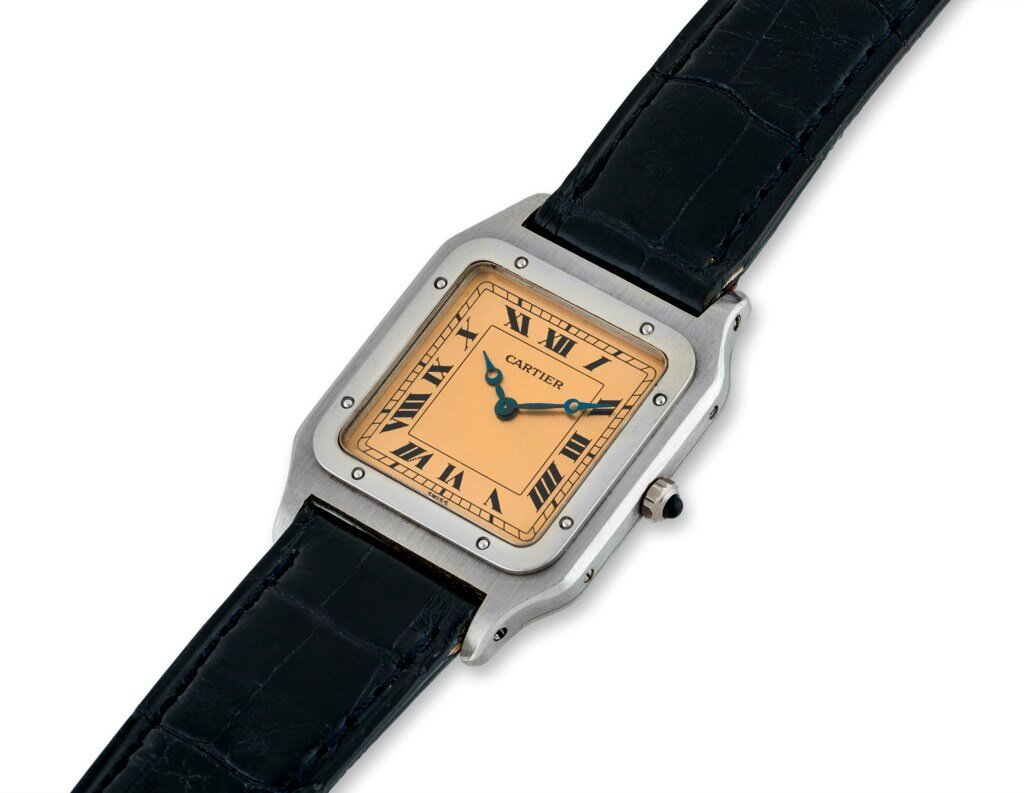Swimming upstream with the Salmon Santos
Indisputably, Cartier makes beautiful watches. As I wrote in my brief history of the Cartier Pasha:
I’ve always struggled with the term “luxury”. There’s a dripping opulence, a Gatsby-esque quality to it. There’s a certain magic to truly desirable “luxury” items. A timeless elegance, transcendent of trends. To me — and I’d bet many others — that’s Cartier.
In modern Cartier (say, since the 1980s — I’d call the two-tone Cartier Santos something of a delineating point between vintage and modern), I’d argue the Cartier Santos-Dumont 90th Anniversary Limited Edition is perhaps the most beautiful Cartier watch, perfectly embodying this magic.
Released in 1994, designed to honor the 90th anniversary of the original Santos-Dumont and limited to just 90 pieces, these watches rarely appear, and popularity (not to mention prices) has risen quickly over the past few years.
Santos-Dumont: Flying back in time
Before taking a look at the 90th Anniversary Limited Edition Santos-Dumont, let’s quickly look at the original timepiece. As the story goes, in 1904, Brazilian aviator Alberto Santos-Dumont complained to friend Louis Cartier about the unreliability and impracticality of using a pocket watch while flying. Cartier designed a flat wristwatch with a square bezel and gave it to Santos-Dumont, and the watch eventually caught on with other customers. Thus, the first mass-produced men’s wristwatch (and first pilot’s watch) was born. While there’s debate about the first humans to take flight — Santos-Dumont or the Wright brothers — there is little debate about the first men’s wristwatch.
The Santos’ case was seemingly inspired by a square pocket watch Cartier had produced, but the highly legible dial design telegraphs a shift to an Art Deco style that would define the 1920s and 1930s, and continues to define Cartier’s design aesthetic to this day.
The case was conceived to be robust and the screws that secure the glass were intended to recall the legs of the new Eiffel tower. Similarly, the blackened Roman numerals suggest the radial layout of Paris’ streets and wide boulevards.
By 1911, Cartier put the Santos-Dumont into full production, with a movement from Jaeger inside, making it the first commercially produced men’s wristwatch. When the Santos-Dumont watch hit shelves in 1911, it was offered in a variety of platinum and yellow gold models, all measuring a svelte, by today’s standards, 25mm x 35mm. The watches usually came with brown or black leather straps with a gold folding buckle. This is where we note another first: Cartier developed the deployant (folding buckle), and for years was the only such mechanism on the market.
‘Salmon’ Santos-Dumont 90th Limited Edition
Credit: Mr. Watchley
The Santos-Dumont 90th Anniversary Limited Edition stays true to the original Santos-Dumont from the turn of the previous century. It features a platinum case that measures 27mm and just 1.5mm thick thanks to the super-slim Piguet caliber 21, it’s definitely a petite watch, but don’t knock it until you’ve tried it. The elongated Roman numerals recall the early Art Deco style of the original Santos-Dumont, and the elegant Breguet hands turn the clock back, as Cartier had mostly moved to simplified stick hands over the years.
Of course, the show stealer of the watch is the rich salmon dial, truly unlike anything else in Cartier’s catalog. It gives the entire timepiece a warm, vintage feel, but the platinum case and numerals make the watch otherwise feel crisp and modern.
The only detail that deviates substantially from the original Santos-Dumont is the smaller crown, which substantially reduces the size of the traditional blue cabachon crown. It makes the Limited Edition more wearable, but does mean the manual wind movement is a bit more difficult to wind every morning.
Swimming upstream
The Santos-Dumont 90th Anniversary Limited edition has exploded in popularity over the past few years. To take just a few recent examples to illustrate the trend: Christie’s sold an example for $7,500 in 2017; Sotheby’s (here) and Christie’s (here) then sold examples for about $12,500 and $13,750, respectively, in 2018. In October 2019, Sotheby’s then sold an example for closer to $17,500. In October, Belgian dealer Mr. Watchley sold an example quicker than it takes to overcook a salmon, and with good reason. It’s the first example I’d seen publicly appear since last year’s Sotheby’s sale. Just look at it:
To chart those auction results referenced above:
October 2017: $7,500 (Christie’s)
May 2018: $12,500 (Sotheby’s)
September 2018: $13,750 (Christie’s)
October 2019: $17,500 (Sotheby’s)
In other words, prices have more than doubled over about two-and-a-half years. Mr. Watchley never listed the price for the example it sold in a matter of hours (minutes?), but the 90th Anniversary Santos-Dumont is surely a $20,000 watch by now, October 2020, A.D.
Listen, Cartier at large has been hot over the course of the past year or so. The Cartier Crash tends to grab all the headlines[1], with six-figure, record-breaking auction results now the norm. But, the trend has trickled down its more modestly priced models as well. It’s easy to try to draw larger lessons from this (is this a broader move towards even smaller, more elegant watches?), but for now let’s just admire this salmon-dialed beauty.
[1] I’m just as guilty of this as anyone, see Exhibits A and B.



